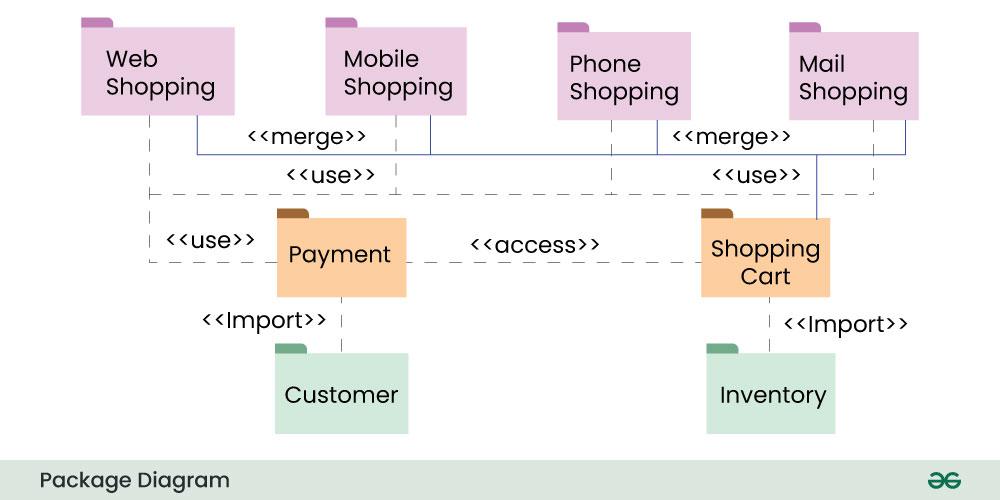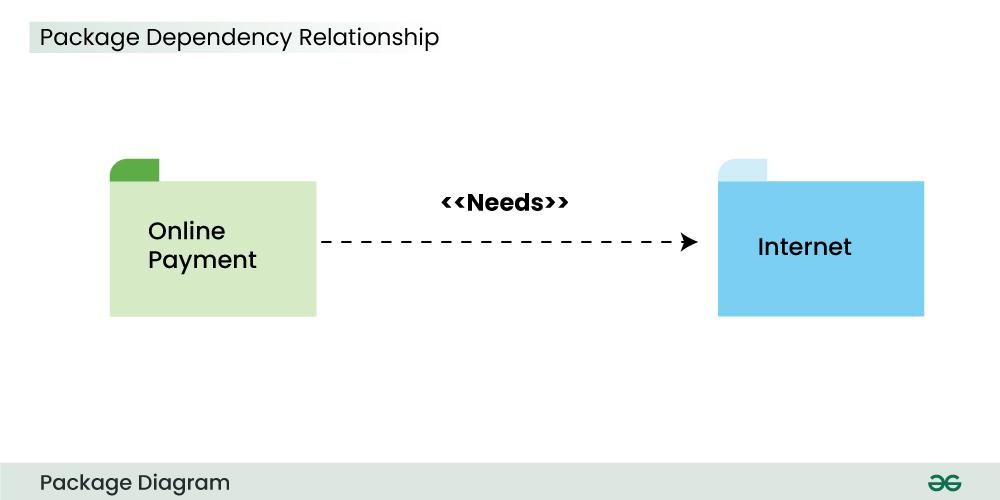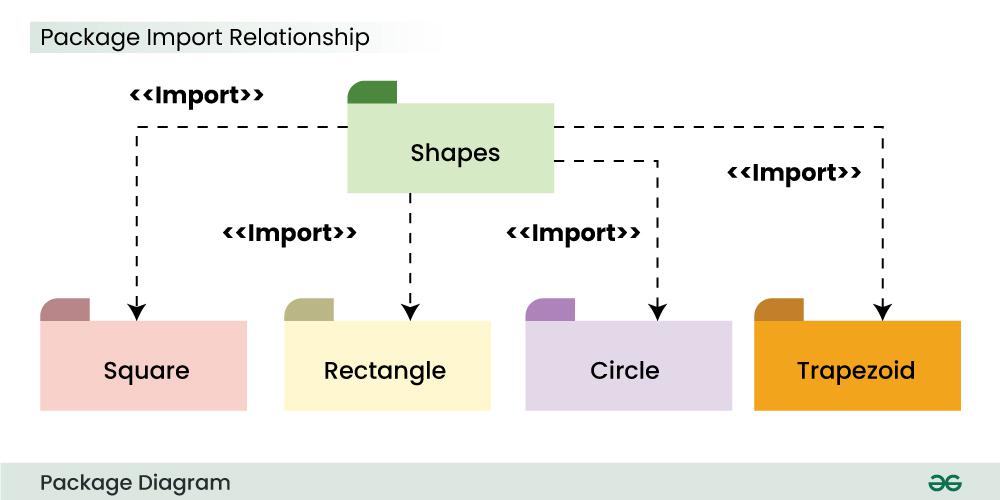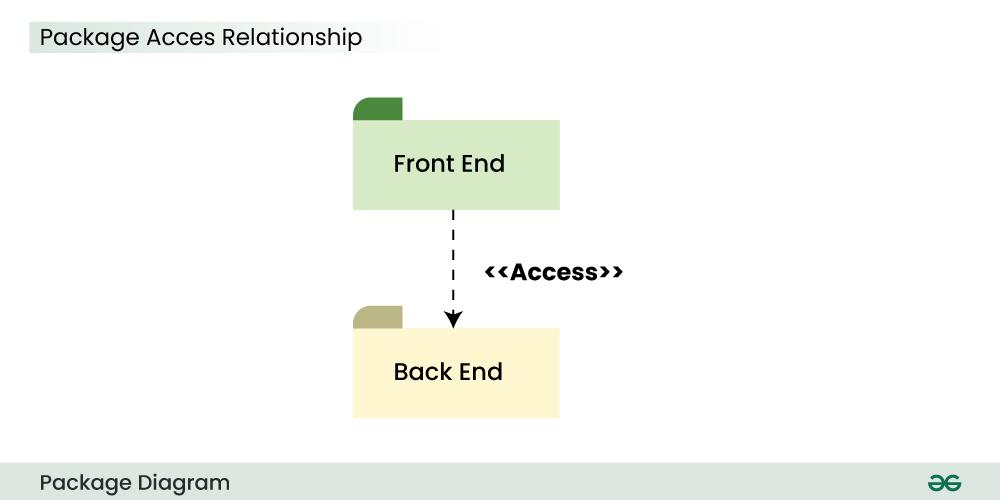Package Diagram – Unified Modeling Language (UML)
Last Updated : 23 Jul, 2025
A package diagram is a type of structural diagram in UML (Unified Modeling Language) that organizes and groups related classes and components into packages. It visually represents the dependencies and relationships between these packages, helping to illustrate how different parts of a system interact with each other.

A package is used as a container to organize the elements present in the system into a more manageable unit. It is very useful to represent the system's architecture and design as a cohesive unit and a concise manner.
Basic Elements of Package Diagrams
The following are the basic elements of a Package Diagrams:

In a package diagram, several key elements help organize and clarify the relationships within a system:
- Package: This is the fundamental unit of a package diagram, serving as a container for various elements like classes and interfaces. It’s depicted as a folder-like icon with a name label, making it easy to identify.
- NameSpace: This denotes the name of the package and usually appears at the top of the package symbol. It helps uniquely identify the package within the diagram.
- Package Merge: This relationship illustrates how one package can be merged with another. It’s represented by a direct arrow between the two packages, indicating that their contents can combine.
- Package Import: This relationship shows that one package can access the contents of another package, depicted with a dashed arrow.
- Dependency: Dependencies indicate that changes in one package may affect another. This relationship signifies that one element or package relies on another, highlighting how interconnected they are.
- Element: An element is a single unit within a package, which can be a class, interface, or subsystem. Elements reside inside packages and are connected to the main package. For instance, a class may contain various functions and variables, all of which are considered elements tied to that class.
- Constraint: This represents a condition or requirement associated with a package, typically shown in curly braces. Constraints help define the rules or limitations for how the package operates.
Package Structure and Notation
Below are the package structures and their notations:
1. Package

The above is the notation of a simple Package.
2. Subsystem

The above notation is used to represent subsystem.
3. Dependency

The above dashed arrow sign is used to show the dependency among two elements or two packages.
4. Import

The above notation is of the Import, here it also uses a dashed arrow line but the difference is, the word <<import>> is being written to represent the below package or function or element has been imported from the above package.
5. Merge

This notation above denotes that the Package 1 can be merged with Package 2
Package Relationships
1. Package Merge Relationship
This relationship is used to represent that the contents of a package can be merged with the contents of another package. This implies that the source and the target package has some elements common in them, so that they can be merged together.
Example:

The above diagram depicts that the packages are of different type of payments, but all of them are a some kind of payment mechanism, so they can all be merged to be called as payment.
2. Package Dependency Relationship
A package can be dependant on other different packages, signifying that the source package is somehow dependent on the target package.
Example:

The above diagram depicts that the online payment package is dependent on the Internet package and uses "need" dependency.
3. Package Import Relationship
This relationship is used to represent that a package is importing another package to use. It signifies that the importing package can access the public contents of the imported package.
Example:

The above package diagram shows the import relationship between the main package Shapes and it's various other sub packages Square, Rectangle etc. They all are importing the real Shapes package so that the public contents of the Shapes package can be used by them.
4. Package Access Relationship
This type of relationship signifies that there is a access relationship between two or more packages, meaning that one package can access the contents of another package without importing it.
Example:

The above diagram depicts the Access relationship between the Front End and Back End services. It is much needed that a front end service can easily access the important Back End services to carry out any operation.
Use Cases of Package Diagrams
A package diagram is a vital tool in system design, helping to model and illustrate the structure of an organization or system. Here are some key use cases:
- It visually represents the system’s structure, organizing elements into smaller, manageable packages. This makes it easier to understand the overall layout.
- The diagram helps manage and organize related modules or components within a system, grouping them for clarity.
- Developers use package diagrams to show dependencies between different packages, which helps clarify the system's architecture and the potential impact of changes.
- System architects can break down complex problems into smaller, manageable parts early in the design process, simplifying component design and implementation.
Best Practices for Package Diagrams
Below are some of the best practices to be followed in case of a Package Diagram:
- It is always recommended to clearly define the package names in such a manner that there is no duplicate present in the same package which might create confusion.
- Organize the packages in a hierarchical manner so that it represents the proper structure of the system and the relationship of the various parts of the system.
- Make the packages concise, use a single package to represent a single function or element. Don't use overcomplicated and complex packages.
- Clearly mention and document the dependencies between the packages using the suitable symbols .This includes dependencies such as associations, generalizations, or dependencies.
Benefits of Package Diagram
Below are the benefits of package diagram:
- It provides a visual representation of the system's architecture, showing that how each elements are organized and interact with each other.
- Package Diagram encourages a modular approach to represent any system in form of smaller and easy to understand packages. It also supports the encapsulation of elements into packages which share a same trait.
- It servers as a common language of commmunication between the developers and the stakeholders.
- By showing the dependency between the different packages, it become easy to identify and manage dependencies between the packages, also it becomes easy to address issues related to coupling and cohesion.
Challenges of Package Diagrams
Below are the challenges of Package diagrams:
- Balancing detail and simplicity in a package diagram is challenging.
- Each package should avoid being overloaded with information to maintain clarity.
- The focus is primarily on the static structure of system elements.
- Package diagrams may not effectively capture dynamic aspects, like runtime behaviors or interactions.
- Dependencies among packages are essential to show, but overemphasis can create clutter.
- Dependencies should be presented clearly and concisely for better understanding.
Package Diagrams in Software Development
Package Diagram plays a significant role in the field of Software Development as a visual representation of an architecture of a system. It helps in understanding , organizing and communication of the structural component of a system.
- Package Diagram provides a high level view of the system's architecture by grouping related elements together to form packages, and representing the dependencies and interactions with each other.
- Package Diagram promotes modularity and encapsulation, which allows the developers to create software with clear boundaries among its components.
- By visually representing classes, interfaces, functions and other elements in a concise manner by including them in a package, software developers can manage the complexity of large software/systems.
Some of the renowned tools and software used to create package diagrams are listed below -
- Enterprise Architect
- Lucidchart
- Visual Paradigm
- Draw.io
- IBM Rhapsody
- PlantUML
- StarUML
- Creately
- Microsoft Visio
Similar Reads
System Design Tutorial System Design is the process of designing the architecture, components, and interfaces for a system so that it meets the end-user requirements. This specifically designed System Design tutorial will help you to learn and master System Design concepts in the most efficient way, from the basics to the
3 min read
Must Know System Design Concepts We all know that System Design is the core concept behind the design of any distributed system. Therefore every person in the tech industry needs to have at least a basic understanding of what goes behind designing a System. With this intent, we have brought to you the ultimate System Design Intervi
15+ min read
What is System Design
System Design Introduction - LLD & HLDSystem design is the process of designing the architecture and components of a software system to meet specific business requirements. Involves translating user requirements into a detailed blueprint that guides the implementation phase. The goal is to create a well-organized and efficient structure
7 min read
System Design Life Cycle | SDLC (Design)System Design Life Cycle is defined as the complete journey of a System from planning to deployment. The System Design Life Cycle is divided into 7 Phases or Stages, which are:1. Planning Stage 2. Feasibility Study Stage 3. System Design Stage 4. Implementation Stage 5. Testing Stage 6. Deployment S
7 min read
What are the components of System Design?System Design involves looking at the system's requirements, determining its assumptions and limitations, and defining its high-level structure and components. The primary elements of system design, including databases, load balancers, and messaging systems, will be discussed.1. Load BalancerIncomin
10 min read
Goals and Objectives of System DesignThe objective of system design is to create a plan for a software or hardware system that meets the needs and requirements of a customer or user. This plan typically includes detailed specifications for the system, including its architecture, components, and interfaces. System design is an important
5 min read
Why is it Important to Learn System Design?System design is an important skill in the tech industry, especially for freshers aiming to grow. Top MNCs like Google and Amazon emphasize system design during interviews, with 40% of recruiters prioritizing it. Beyond interviews, it helps in the development of scalable and effective solutions to a
6 min read
Important Key Concepts and Terminologies – Learn System DesignSystem Design is the core concept behind the design of any distributed systems. System Design is defined as a process of creating an architecture for different components, interfaces, and modules of the system and providing corresponding data helpful in implementing such elements in systems. In this
9 min read
Advantages of System DesignSystem Design is the process of designing the architecture, components, and interfaces for a system so that it meets the end-user requirements. System Design for tech interviews is something that can’t be ignored! Almost every IT giant whether it be Facebook, Amazon, Google, Apple or any other asks
4 min read
System Design Fundamentals
Analysis of Monolithic and Distributed Systems - Learn System DesignSystem analysis is the process of gathering the requirements of the system prior to the designing system in order to study the design of our system better so as to decompose the components to work efficiently so that they interact better which is very crucial for our systems. System design is a syst
10 min read
What is Requirements Gathering Process in System Design?The first and most essential stage in system design is requirements collecting. It identifies and documents the needs of stakeholders to guide developers during the building process. This step makes sure the final system meets expectations by defining project goals and deliverables. We will explore
7 min read
Differences between System Analysis and System DesignSystem Analysis and System Design are two stages of the software development life cycle. System Analysis is a process of collecting and analyzing the requirements of the system whereas System Design is a process of creating a design for the system to meet the requirements. Both are important stages
4 min read
Horizontal and Vertical Scaling | System DesignIn system design, scaling is crucial for managing increased loads. Horizontal scaling and vertical scaling are two different approaches to scaling a system, both of which can be used to improve the performance and capacity of the system. Why do we need Scaling?We need scaling to built a resilient sy
5 min read
Capacity Estimation in Systems DesignCapacity Estimation in Systems Design explores predicting how much load a system can handle. Imagine planning a party where you need to estimate how many guests your space can accommodate comfortably without things getting chaotic. Similarly, in technology, like websites or networks, we must estimat
10 min read
Object-Oriented Analysis and Design(OOAD)Object-Oriented Analysis and Design (OOAD) is a way to design software by thinking of everything as objects similar to real-life things. In OOAD, we first understand what the system needs to do, then identify key objects, and finally decide how these objects will work together. This approach helps m
6 min read
How to Answer a System Design Interview Problem/Question?System design interviews are crucial for software engineering roles, especially senior positions. These interviews assess your ability to architect scalable, efficient systems. Unlike coding interviews, they focus on overall design, problem-solving, and communication skills. You need to understand r
5 min read
Functional vs. Non Functional RequirementsRequirements analysis is an essential process that enables the success of a system or software project to be assessed. Requirements are generally split into two types: Functional and Non-functional requirements. functional requirements define the specific behavior or functions of a system. In contra
6 min read
Communication Protocols in System DesignModern distributed systems rely heavily on communication protocols for both design and operation.Communication protocols facilitate smooth coordination and communication in distributed systems by defining the norms and guidelines for message exchange between various components.By choosing the right
6 min read
Web Server, Proxies and their role in Designing SystemsIn system design, web servers and proxies are crucial components that facilitate seamless user-application communication. Web pages, images, or data are delivered by a web server in response to requests from clients, like browsers. A proxy, on the other hand, acts as a mediator between clients and s
9 min read
Scalability in System Design
Databases in Designing Systems
Complete Guide to Database Design - System DesignDatabase design is key to building fast and reliable systems. It involves organizing data to ensure performance, consistency, and scalability while meeting application needs. From choosing the right database type to structuring data efficiently, good design plays a crucial role in system success. Th
11 min read
SQL vs. NoSQL - Which Database to Choose in System Design?When designing a system, one of the most critical system design choices is among SQL vs. NoSQL databases can drastically impact your system's overall performance, scalability, and usual success. What is SQL Database?Here are some key features of SQL databases:Tabular Data Model: SQL databases organi
5 min read
File and Database Storage Systems in System DesignFile and database storage systems are important to the effective management and arrangement of data in system design. These systems offer a structure for data organization, retrieval, and storage in applications while guaranteeing data accessibility and integrity. Database systems provide structured
4 min read
Block, Object, and File Storage in System DesignStorage is a key part of system design, and understanding the types of storage can help you build efficient systems. Block, object, and file storage are three common methods, each suited for specific use cases. Block storage is like building blocks for structured data, object storage handles large,
5 min read
Database Sharding - System DesignDatabase sharding is a technique for horizontal scaling of databases, where the data is split across multiple database instances, or shards, to improve performance and reduce the impact of large amounts of data on a single database.Database ShardingIt is basically a database architecture pattern in
8 min read
Database Replication in System DesignMaking and keeping duplicate copies of a database on other servers is known as database replication. It is essential for improving modern systems' scalability, reliability, and data availability.By distributing their data across multiple servers, organizations can guarantee that it will remain acces
6 min read
High Level Design(HLD)
What is High Level Design? - Learn System DesignHigh-level design or HLD is an initial step in the development of applications where the overall structure of a system is planned. Focuses mainly on how different components of the system work together without getting to know about internal coding and implementation. Helps everyone involved in the p
9 min read
Availability in System DesignA system or service's readiness and accessibility to users at any given moment is referred to as availability. It calculates the proportion of time a system is available and functional. Redundancy, fault tolerance, and effective recovery techniques are usually used to achieve high availability, whic
5 min read
Consistency in System DesignConsistency in system design refers to the property of ensuring that all nodes in a distributed system have the same view of the data at any given point in time, despite possible concurrent operations and network delays.Importance of Consistency in System DesignConsistency plays a crucial role in sy
8 min read
Reliability in System DesignReliability is crucial in system design, ensuring consistent performance and minimal failures. System reliability refers to how consistently a system performs its intended functions without failure over a given period under specified operating conditions. It means the system can be trusted to work c
5 min read
CAP Theorem in System DesignAccording to the CAP theorem, only two of the three desirable characteristics—consistency, availability, and partition tolerance—can be shared or present in a networked shared-data system or distributed system.The theorem provides a way of thinking about the trade-offs involved in designing and buil
5 min read
What is API Gateway?An API Gateway is a key component in system design, particularly in microservices architectures and modern web applications. It serves as a centralized entry point for managing and routing requests from clients to the appropriate microservices or backend services within a system. An API Gateway serv
8 min read
What is Content Delivery Network(CDN) in System DesignThese days, user experience and website speed are crucial. Content Delivery Networks (CDNs) are useful in this situation. A distributed network of servers that work together to deliver content (like images, videos, and static files) to users faster and more efficiently.These servers, called edge ser
7 min read
What is Load Balancer & How Load Balancing works?A load balancer is a networking device or software application that distributes and balances the incoming traffic among the servers to provide high availability, efficient utilization of servers, and high performance. Works as a “traffic cop†routing client requests across all serversEnsures that no
8 min read
Caching - System Design ConceptCaching is a system design concept that involves storing frequently accessed data in a location that is easily and quickly accessible. The purpose of caching is to improve the performance and efficiency of a system by reducing the amount of time it takes to access frequently accessed data.=Caching a
9 min read
Communication Protocols in System DesignModern distributed systems rely heavily on communication protocols for both design and operation.Communication protocols facilitate smooth coordination and communication in distributed systems by defining the norms and guidelines for message exchange between various components.By choosing the right
6 min read
Activity Diagrams - Unified Modeling Language (UML)Activity diagrams are an essential part of the Unified Modeling Language (UML) that help visualize workflows, processes, or activities within a system. They depict how different actions are connected and how a system moves from one state to another. By offering a clear picture of both simple and com
10 min read
Message Queues - System DesignMessage queues enable communication between various system components, which makes them crucial to system architecture. Serve as buffers and allow messages to be sent and received asynchronously, enabling systems to function normally even if certain components are temporarily or slowly unavailable.
8 min read
Low Level Design(LLD)
What is Low Level Design or LLD?Low-Level Design (LLD) plays a crucial role in software development, transforming high-level abstract concepts into detailed, actionable components that developers can use to build the system. LLD is the blueprint that guides developers on how to implement specific components of a system, such as cl
6 min read
Authentication vs Authorization in LLD - System DesignTwo fundamental ideas in system design, particularly in low-level design (LLD), are authentication and authorization. Authentication confirms a person's identity.Authorization establishes what resources or actions a user is permitted to access.Authentication MethodsPassword-based AuthenticationDescr
3 min read
Performance Optimization Techniques for System DesignThe ability to design systems that are not only functional but also optimized for performance and scalability is essential. As systems grow in complexity, the need for effective optimization techniques becomes increasingly critical. Data Structures & AlgorithmsChoose data structures (hash tables
3 min read
Object-Oriented Analysis and Design(OOAD)Object-Oriented Analysis and Design (OOAD) is a way to design software by thinking of everything as objects similar to real-life things. In OOAD, we first understand what the system needs to do, then identify key objects, and finally decide how these objects will work together. This approach helps m
6 min read
Data Structures and Algorithms for System DesignSystem design relies on Data Structures and Algorithms (DSA) to provide scalable and effective solutions. They assist engineers with data organization, storage, and processing so they can efficiently address real-world issues. In system design, understanding DSA concepts like arrays, trees, graphs,
6 min read
Containerization Architecture in System DesignIn system design, containerization architecture describes the process of encapsulating an application and its dependencies into a portable, lightweight container that is easily deployable in a variety of computing environments. Because it makes the process of developing, deploying, and scaling appli
10 min read
Modularity and Interfaces In System DesignThe process of breaking down a complex system into smaller, more manageable components or modules is known as modularity in system design. Each module is designed to perform a certain task or function, and these modules work together to achieve the overall functionality of the system.Many fields, su
8 min read
Unified Modeling Language (UML) DiagramsUnified Modeling Language (UML) is a general-purpose modeling language. The main aim of UML is to define a standard way to visualize the way a system has been designed. It is quite similar to blueprints used in other fields of engineering. UML is not a programming language, it is rather a visual lan
14 min read
Data Partitioning Techniques in System DesignUsing data partitioning techniques, a huge dataset can be divided into smaller, easier-to-manage portions. These techniques are applied in a variety of fields, including distributed systems, parallel computing, and database administration. Data Partitioning Techniques in System DesignTable of Conten
9 min read
How to Prepare for Low-Level Design Interviews?Low-Level Design (LLD) interviews are crucial for many tech roles, especially for software developers and engineers. These interviews test your ability to design detailed components and interactions within a system, ensuring that you can translate high-level requirements into concrete implementation
4 min read
Essential Security Measures in System DesignWith various threats like cyberattacks, Data Breaches, and other Vulnerabilities, it has become very important for system administrators to incorporate robust security measures into their systems. Some of the key reasons are given below:Protection Against Cyber Threats: Data Breaches, Hacking, DoS a
8 min read
Design Patterns
Design Patterns TutorialSoftware design patterns are important tools developers, providing proven solutions to common problems encountered during software development. Reusable solutions for typical software design challenges are known as design patterns. Provide a standard terminology and are specific to particular scenar
9 min read
Creational Design PatternsCreational Design Patterns focus on the process of object creation or problems related to object creation. They help in making a system independent of how its objects are created, composed, and represented. Creational patterns give a lot of flexibility in what gets created, who creates it, and how i
4 min read
Structural Design PatternsStructural Design Patterns are solutions in software design that focus on how classes and objects are organized to form larger, functional structures. These patterns help developers simplify relationships between objects, making code more efficient, flexible, and easy to maintain. By using structura
7 min read
Behavioral Design PatternsBehavioral design patterns are a category of design patterns that focus on the interactions and communication between objects. They help define how objects collaborate and distribute responsibility among them, making it easier to manage complex control flow and communication in a system. Table of Co
5 min read
Design Patterns Cheat Sheet - When to Use Which Design Pattern?In system design, selecting the right design pattern is related to choosing the right tool for the job. It's essential for crafting scalable, maintainable, and efficient systems. Yet, among a lot of options, the decision can be difficult. This Design Patterns Cheat Sheet serves as a guide, helping y
7 min read
Interview Guide for System Design
How to Crack System Design Interview Round?In the System Design Interview round, You will have to give a clear explanation about designing large scalable distributed systems to the interviewer. This round may be challenging and complex for you because you are supposed to cover all the topics and tradeoffs within this limited time frame, whic
9 min read
System Design Interview Questions and Answers [2025]In the hiring procedure, system design interviews play a significant role for many tech businesses, particularly those that develop large, reliable software systems. In order to satisfy requirements like scalability, reliability, performance, and maintainability, an extensive plan for the system's a
7 min read
Most Commonly Asked System Design Interview Problems/QuestionsThis System Design Interview Guide will provide the most commonly asked system design interview questions and equip you with the knowledge and techniques needed to design, build, and scale your robust applications, for professionals and newbiesBelow are a list of most commonly asked interview proble
1 min read
5 Common System Design Concepts for Interview PreparationIn the software engineering interview process system design round has become a standard part of the interview. The main purpose of this round is to check the ability of a candidate to build a complex and large-scale system. Due to the lack of experience in building a large-scale system a lot of engi
12 min read
5 Tips to Crack Low-Level System Design InterviewsCracking low-level system design interviews can be challenging, but with the right approach, you can master them. This article provides five essential tips to help you succeed. These tips will guide you through the preparation process. Learn how to break down complex problems, communicate effectivel
6 min read